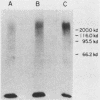Abstract
Leishmania spp. must attach to mononuclear phagocyte surfaces before entering this host cell. We investigated the potential role of fibronectin in facilitating parasite attachment. Human plasma fibronectin bound to axenically cultured promastigotes, and promastigotes and amastigotes preferentially bound to fibronectin-coated cover slips. Promastigotes grown in the absence of fibronectin were strikingly deficient in their ability to attach to human monocytes compared with promastigotes grown in the presence of fibronectin. Rabbit anti-human plasma fibronectin antiserum decreased promastigote and amastigote attachment to monocytes. Immunoglobulin G F(ab')2 and Fab fragments also reduced the ability of amastigotes to bind to monocytes. Antiserum pretreatment of amastigotes followed by washing resulted in reduced parasite binding, whereas antibody pretreatment of monocytes did not. Addition of exogenous fibronectin did not enhance parasite attachment to monocytes. These findings suggest that Leishmania spp. can bind fibronectin and may utilize this glycoprotein to facilitate attachment to the mononuclear phagocytes that they infect.
Full text
PDF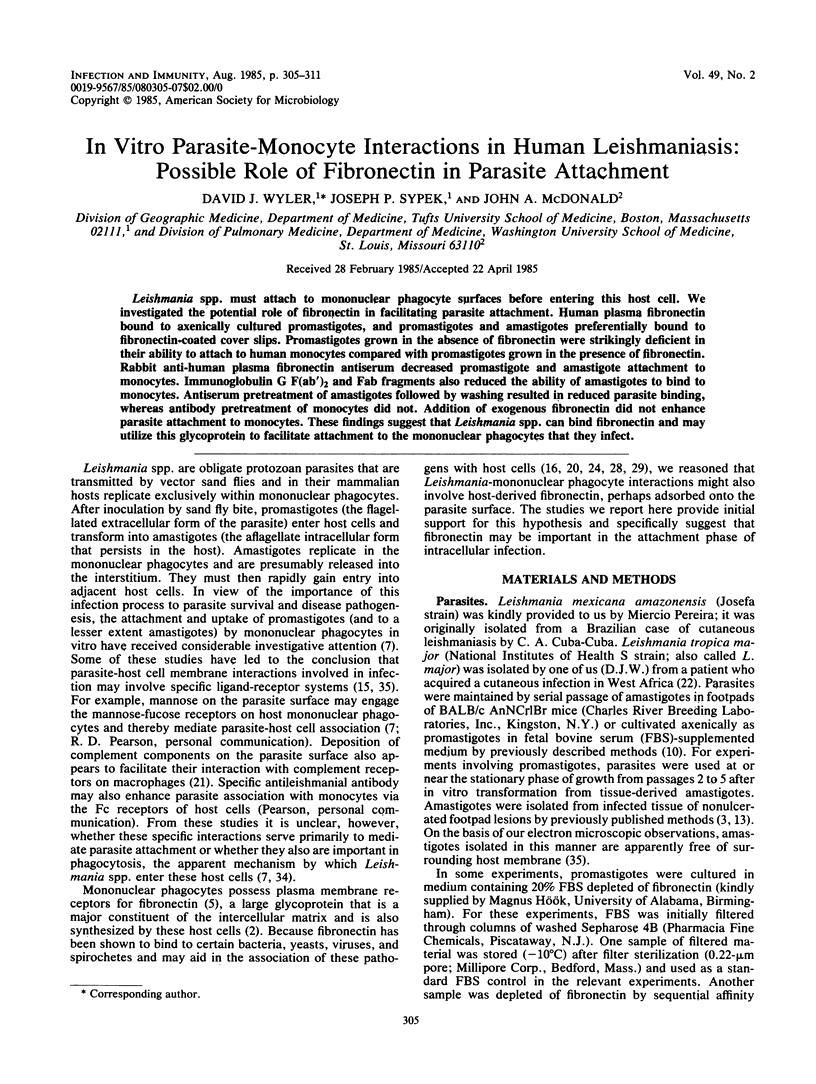
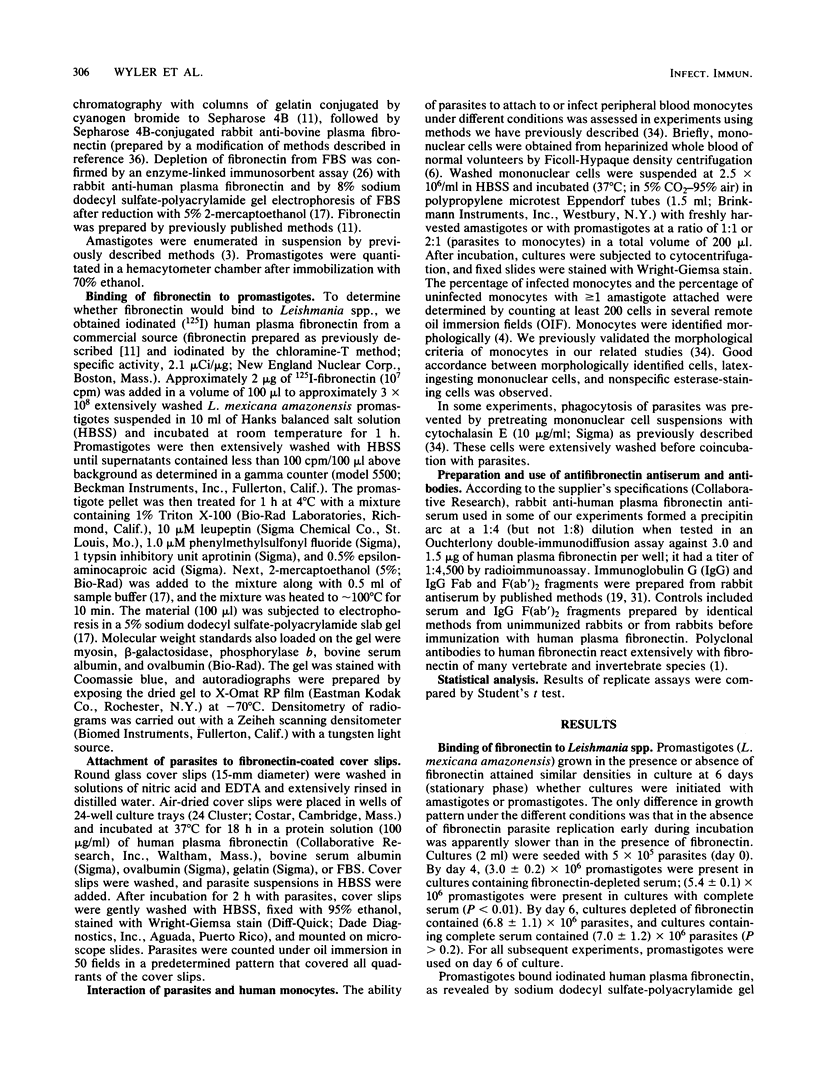
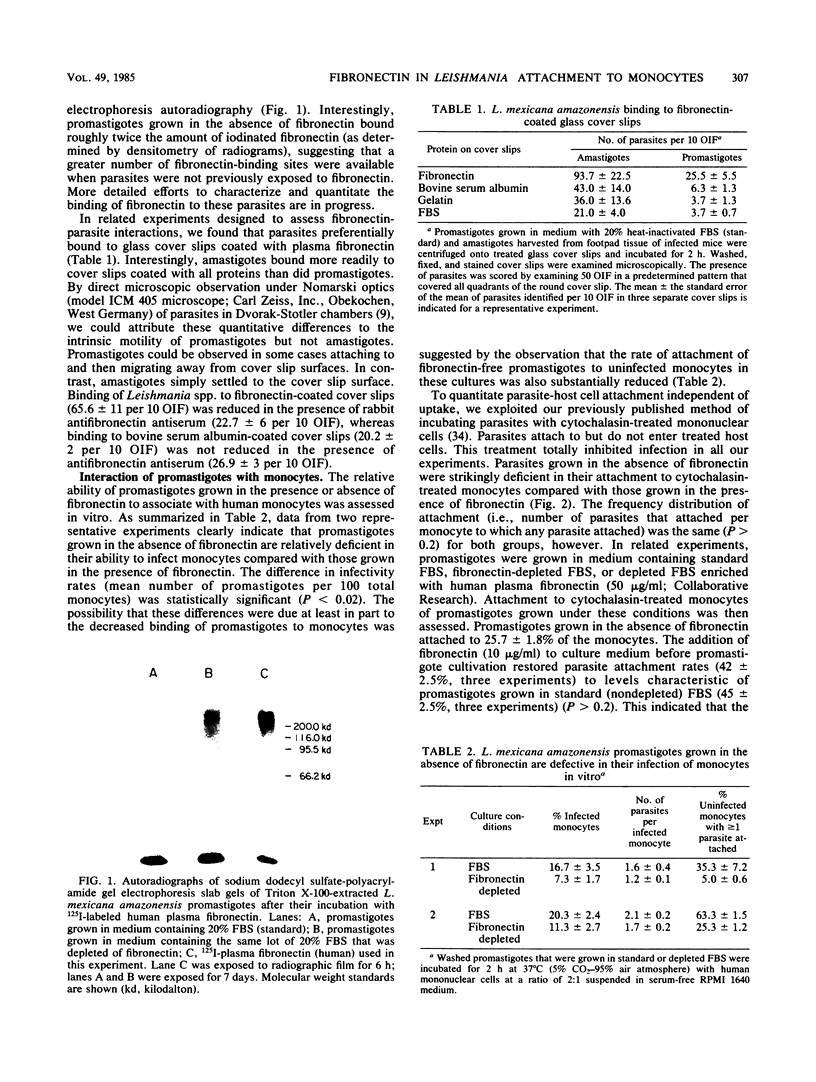
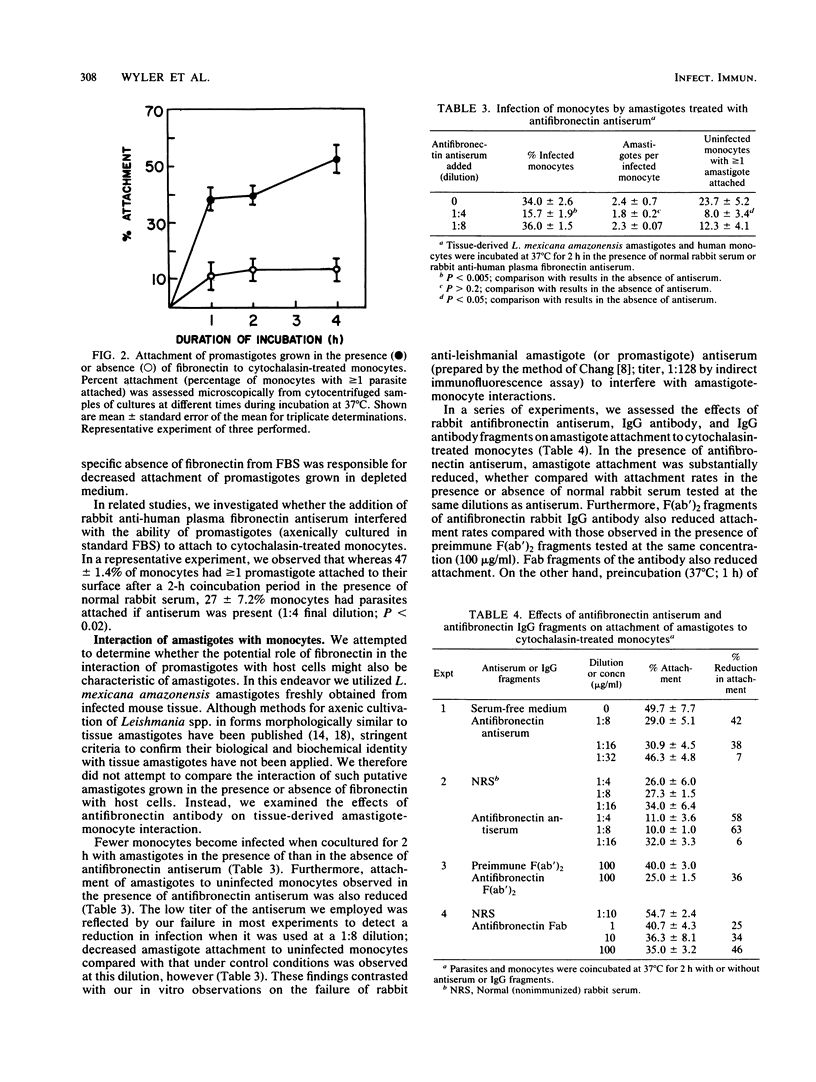
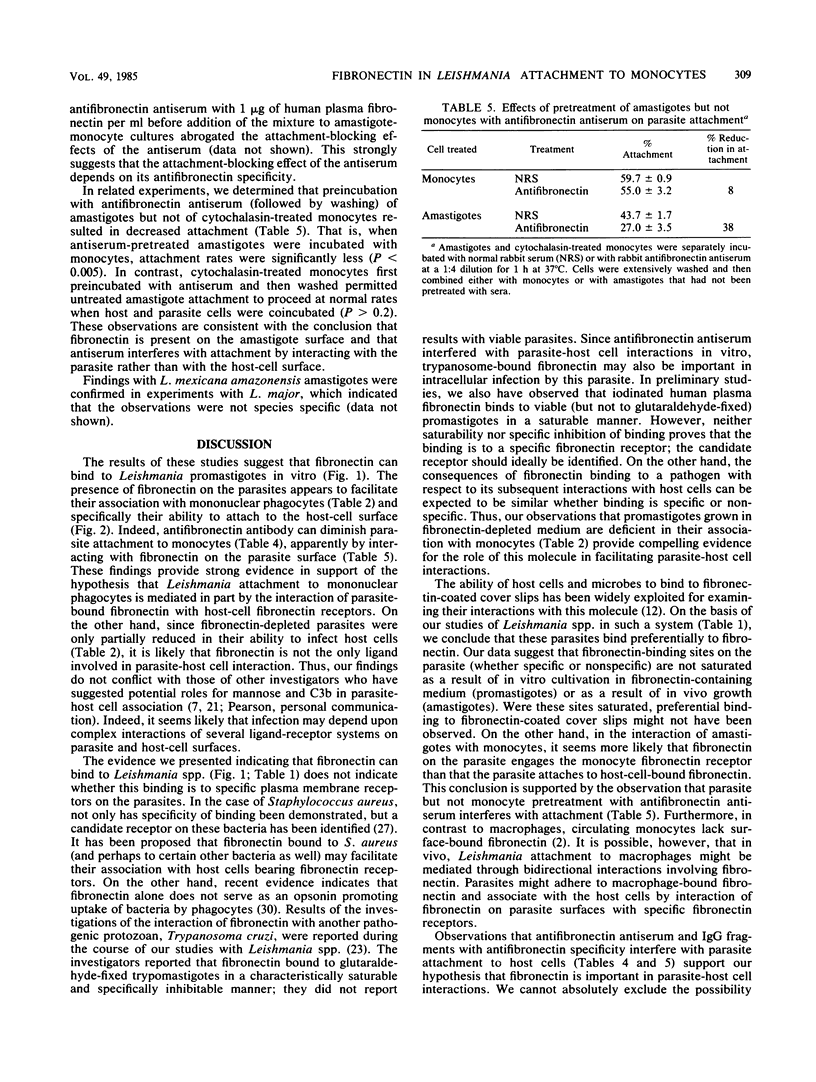
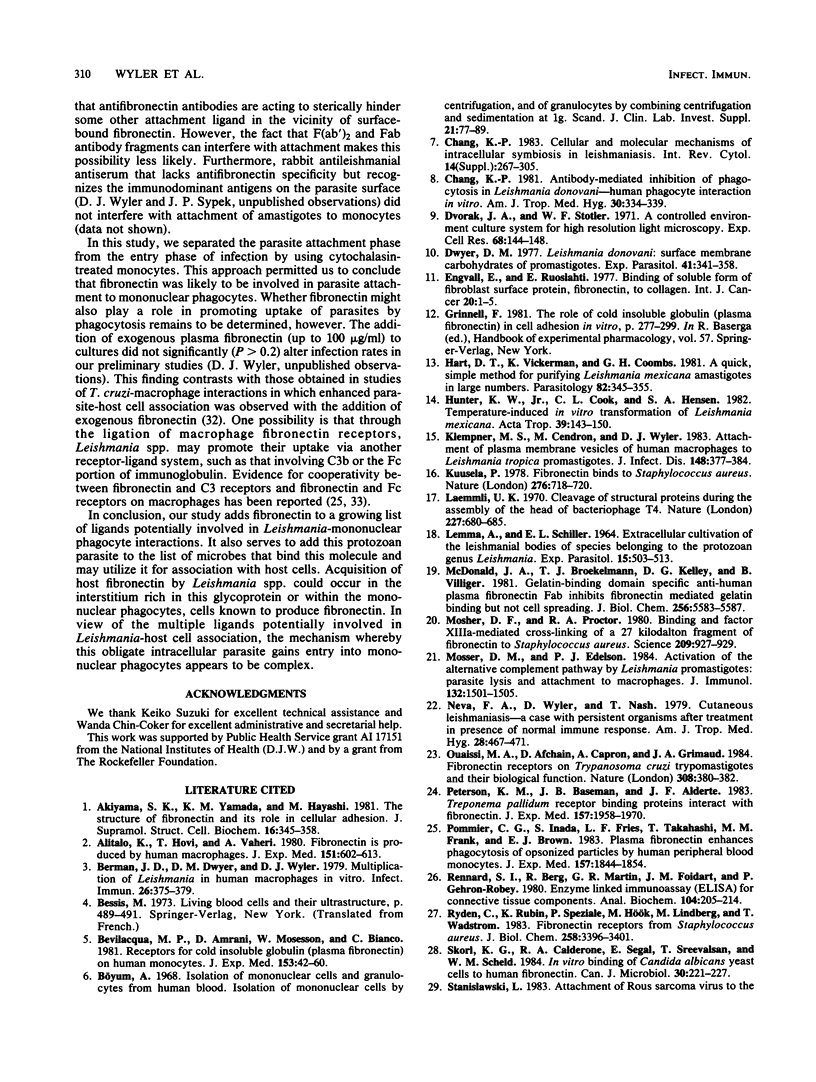
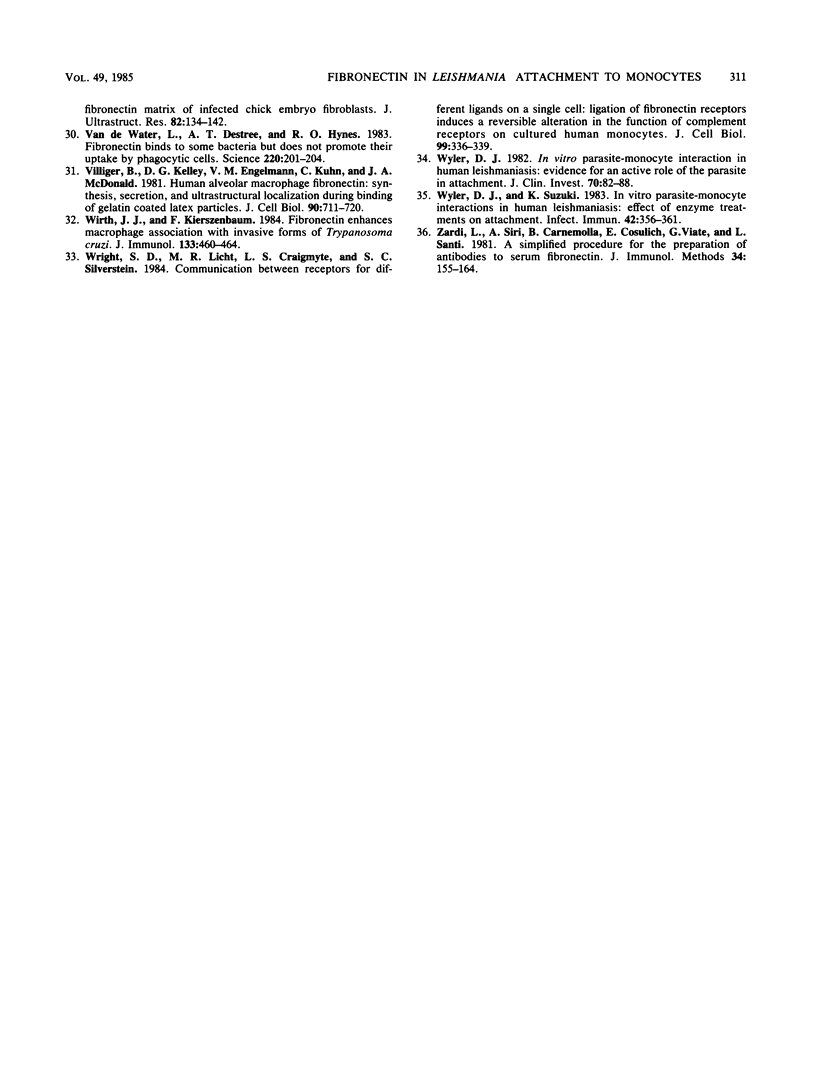
Images in this article
Selected References
These references are in PubMed. This may not be the complete list of references from this article.
- Akiyama S. K., Yamada K. M., Hayashi M. The structure of fibronectin and its role in cellular adhesion. J Supramol Struct Cell Biochem. 1981;16(4):345–348. doi: 10.1002/jsscb.1981.380160405. [DOI] [PubMed] [Google Scholar]
- Alitalo K., Hovi T., Vaheri A. Fibronectin is produced by human macrophages. J Exp Med. 1980 Mar 1;151(3):602–613. doi: 10.1084/jem.151.3.602. [DOI] [PMC free article] [PubMed] [Google Scholar]
- Berman J. D., Dwyer D. M., Wyler D. J. Multiplication of Leishmania in human macrophages in vitro. Infect Immun. 1979 Oct;26(1):375–379. doi: 10.1128/iai.26.1.375-379.1979. [DOI] [PMC free article] [PubMed] [Google Scholar]
- Bevilacqua M. P., Amrani D., Mosesson M. W., Bianco C. Receptors for cold-insoluble globulin (plasma fibronectin) on human monocytes. J Exp Med. 1981 Jan 1;153(1):42–60. doi: 10.1084/jem.153.1.42. [DOI] [PMC free article] [PubMed] [Google Scholar]
- Chang K. P. Antibody-mediated inhibition of phagocytosis in Leishmania donovani-human phagocyte interactions in vitro. Am J Trop Med Hyg. 1981 Mar;30(2):334–339. doi: 10.4269/ajtmh.1981.30.334. [DOI] [PubMed] [Google Scholar]
- Chang K. P. Cellular and molecular mechanisms of intracellular symbiosis in leishmaniasis. Int Rev Cytol Suppl. 1983;14:267–305. [PubMed] [Google Scholar]
- Dvorak J. A., Stotler W. F. A controlled-environment culture system for high resolution light microscopy. Exp Cell Res. 1971 Sep;68(1):144–148. doi: 10.1016/0014-4827(71)90596-9. [DOI] [PubMed] [Google Scholar]
- Dwyer D. M. Leishmania donovani: surface membrane carbohydrates of promastigotes. Exp Parasitol. 1977 Apr;41(2):341–358. doi: 10.1016/0014-4894(77)90107-2. [DOI] [PubMed] [Google Scholar]
- Engvall E., Ruoslahti E. Binding of soluble form of fibroblast surface protein, fibronectin, to collagen. Int J Cancer. 1977 Jul 15;20(1):1–5. doi: 10.1002/ijc.2910200102. [DOI] [PubMed] [Google Scholar]
- Hart D. T., Vickerman K., Coombs G. H. A quick, simple method for purifying Leishmania mexicana amastigotes in large numbers. Parasitology. 1981 Jun;82(Pt 3):345–355. doi: 10.1017/s0031182000066889. [DOI] [PubMed] [Google Scholar]
- Hunter K. W., Jr, Cook C. L., Hensen S. A. Temperature-induced in vitro transformation of Leishmania mexicana. I. Ultrastructural comparison of culture-transformed and intracellular amastigotes. Acta Trop. 1982 Jun;39(2):143–150. [PubMed] [Google Scholar]
- Klempner M. S., Cendron M., Wyler D. J. Attachment of plasma membrane vesicles of human macrophages to Leishmania tropica promastigotes. J Infect Dis. 1983 Sep;148(3):377–384. doi: 10.1093/infdis/148.3.377. [DOI] [PubMed] [Google Scholar]
- Kuusela P. Fibronectin binds to Staphylococcus aureus. Nature. 1978 Dec 14;276(5689):718–720. doi: 10.1038/276718a0. [DOI] [PubMed] [Google Scholar]
- LEMMA A., SCHILLER E. L. EXTRACELLULAR CULTIVATION OF THE LEISHMANIAL BODIES OF SPECIES BELONGING TO THE PROTOZOAN GENUS LEISHMANIA. Exp Parasitol. 1964 Dec;15:503–513. doi: 10.1016/0014-4894(64)90043-8. [DOI] [PubMed] [Google Scholar]
- Laemmli U. K. Cleavage of structural proteins during the assembly of the head of bacteriophage T4. Nature. 1970 Aug 15;227(5259):680–685. doi: 10.1038/227680a0. [DOI] [PubMed] [Google Scholar]
- McDonald J. A., Broekelmann T. J., Kelley D. G., Villiger B. Gelatin-binding domain-specific anti-human plasma fibronectin Fab' inhibits fibronectin-mediated gelatin binding but not cell spreading. J Biol Chem. 1981 Jun 10;256(11):5583–5587. [PubMed] [Google Scholar]
- Mosher D. F., Proctor R. A. Binding and factor XIIIa-mediated cross-linking of a 27-kilodalton fragment of fibronectin to Staphylococcus aureus. Science. 1980 Aug 22;209(4459):927–929. doi: 10.1126/science.7403857. [DOI] [PubMed] [Google Scholar]
- Mosser D. M., Edelson P. J. Activation of the alternative complement pathway by Leishmania promastigotes: parasite lysis and attachment to macrophages. J Immunol. 1984 Mar;132(3):1501–1505. [PubMed] [Google Scholar]
- Neva F. A., Wyler D., Nash T. Cutaneous leishmaniasis--a case with persistent organisms after treatment in presence of normal immune response. Am J Trop Med Hyg. 1979 May;28(3):467–471. [PubMed] [Google Scholar]
- Ouaissi M. A., Afchain D., Capron A., Grimaud J. A. Fibronectin receptors on Trypanosoma cruzi trypomastigotes and their biological function. Nature. 1984 Mar 22;308(5957):380–382. doi: 10.1038/308380a0. [DOI] [PubMed] [Google Scholar]
- Peterson K. M., Baseman J. B., Alderete J. F. Treponema pallidum receptor binding proteins interact with fibronectin. J Exp Med. 1983 Jun 1;157(6):1958–1970. doi: 10.1084/jem.157.6.1958. [DOI] [PMC free article] [PubMed] [Google Scholar]
- Pommier C. G., Inada S., Fries L. F., Takahashi T., Frank M. M., Brown E. J. Plasma fibronectin enhances phagocytosis of opsonized particles by human peripheral blood monocytes. J Exp Med. 1983 Jun 1;157(6):1844–1854. doi: 10.1084/jem.157.6.1844. [DOI] [PMC free article] [PubMed] [Google Scholar]
- Rennard S. I., Berg R., Martin G. R., Foidart J. M., Robey P. G. Enzyme-linked immunoassay (ELISA) for connective tissue components. Anal Biochem. 1980 May 1;104(1):205–214. doi: 10.1016/0003-2697(80)90300-0. [DOI] [PubMed] [Google Scholar]
- Rydén C., Rubin K., Speziale P., Hök M., Lindberg M., Wadström T. Fibronectin receptors from Staphylococcus aureus. J Biol Chem. 1983 Mar 10;258(5):3396–3401. [PubMed] [Google Scholar]
- Skerl K. G., Calderone R. A., Segal E., Sreevalsan T., Scheld W. M. In vitro binding of Candida albicans yeast cells to human fibronectin. Can J Microbiol. 1984 Feb;30(2):221–227. doi: 10.1139/m84-033. [DOI] [PubMed] [Google Scholar]
- Stanislawski L. Attachment of rous sarcoma virus to the fibronectin matrix of infected chick embryo fibroblasts. J Ultrastruct Res. 1983 Feb;82(2):134–142. doi: 10.1016/s0022-5320(83)90048-5. [DOI] [PubMed] [Google Scholar]
- Van de Water L., Destree A. T., Hynes R. O. Fibronectin binds to some bacteria but does not promote their uptake by phagocytic cells. Science. 1983 Apr 8;220(4593):201–204. doi: 10.1126/science.6338594. [DOI] [PubMed] [Google Scholar]
- Villiger B., Kelley D. G., Engleman W., Kuhn C., 3rd, McDonald J. A. Human alveolar macrophage fibronectin: synthesis, secretion, and ultrastructural localization during gelatin-coated latex particle binding. J Cell Biol. 1981 Sep;90(3):711–720. doi: 10.1083/jcb.90.3.711. [DOI] [PMC free article] [PubMed] [Google Scholar]
- Wirth J. J., Kierszenbaum F. Fibronectin enhances macrophage association with invasive forms of Trypanosoma cruzi. J Immunol. 1984 Jul;133(1):460–464. [PubMed] [Google Scholar]
- Wright S. D., Licht M. R., Craigmyle L. S., Silverstein S. C. Communication between receptors for different ligands on a single cell: ligation of fibronectin receptors induces a reversible alteration in the function of complement receptors on cultured human monocytes. J Cell Biol. 1984 Jul;99(1 Pt 1):336–339. doi: 10.1083/jcb.99.1.336. [DOI] [PMC free article] [PubMed] [Google Scholar]
- Wyler D. J. In vitro parasite-monocyte interactions in human leishmaniasis. Evidence for an active role of the parasite in attachment. J Clin Invest. 1982 Jul;70(1):82–88. doi: 10.1172/JCI110606. [DOI] [PMC free article] [PubMed] [Google Scholar]
- Wyler D. J., Suzuki K. In vitro parasite-monocyte interactions in human leishmaniasis: effect of enzyme treatments on attachment. Infect Immun. 1983 Oct;42(1):356–361. doi: 10.1128/iai.42.1.356-361.1983. [DOI] [PMC free article] [PubMed] [Google Scholar]
- Zardi L., Siri A., Carnemolla B., Cosulich E., Viale G., Santi L. A simplified procedure for the preparation of antibodies to serum fibronectin. J Immunol Methods. 1980;34(2):155–165. doi: 10.1016/0022-1759(80)90169-6. [DOI] [PubMed] [Google Scholar]



